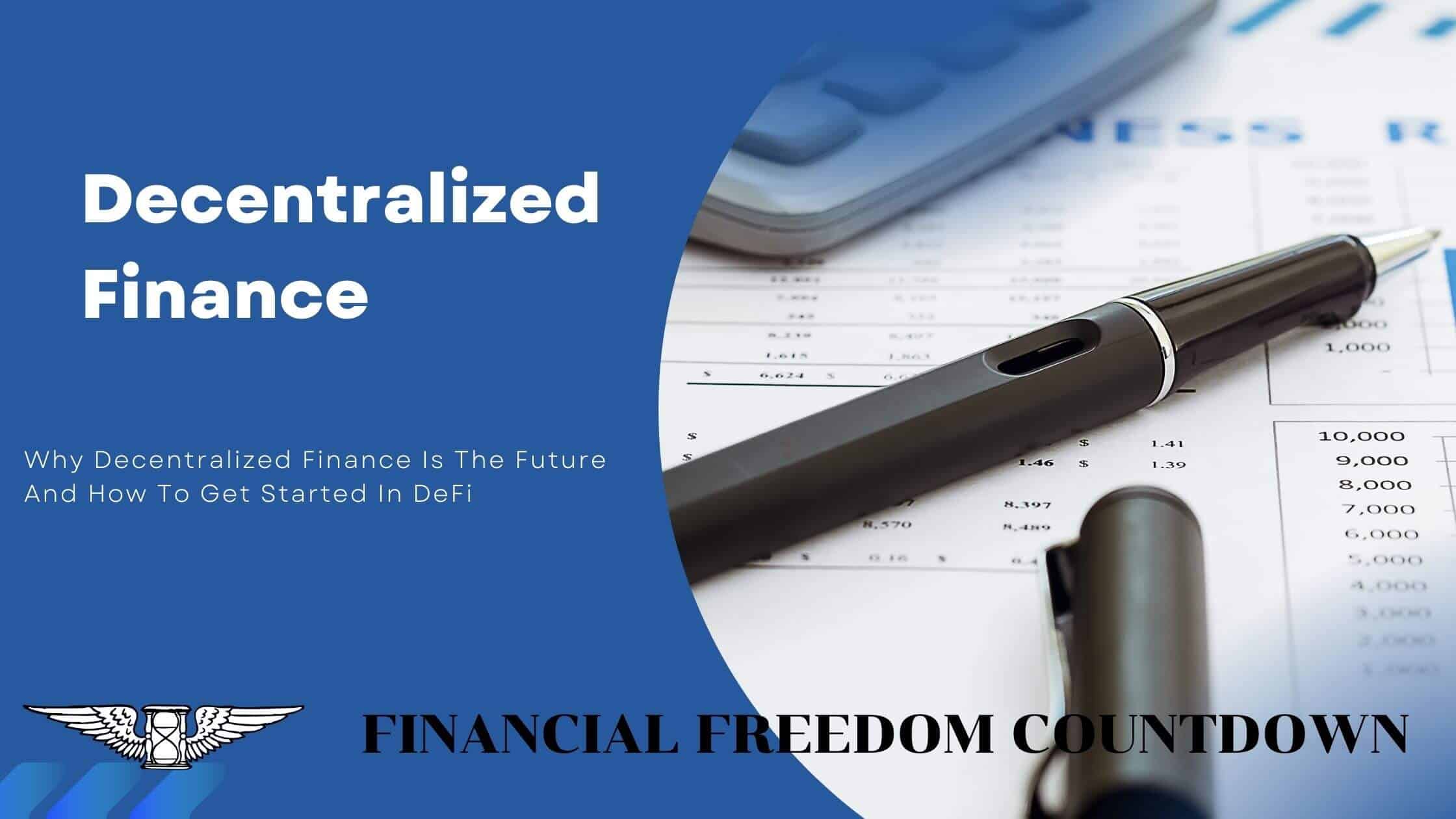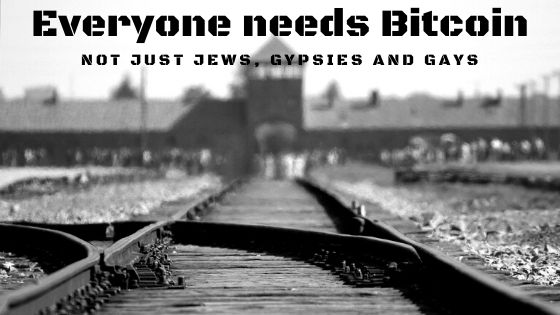Why Decentralized Finance Is the Future and How To Get Started in DeFi

The world of crypto and blockchains is innovating at a rapid pace. Decentralized Finance, also known as DeFi, is another way for traders and investors to profit using digital assets. If someone is used to investing in stocks and bonds on a centralized exchange like a bank or brokerage firm, getting started in Decentralized Finance can be confusing. Once the basics are understood, most traders will find several ways to profit from these exciting digital assets.
What is DeFi?
DeFi stands for decentralized Finance and is a term that covers financial services such as borrowing money, earning interest, trading assets, or lending money using blockchain technology.
The Ethereum blockchain has many DeFi assets, although other Layer 1 protocols are gaining popularity. The benefit of DeFi is that I can do several more financial transactions using decentralized Finance, including those I can do with banks and other centralized financial services.
In some ways, DeFi is better than using traditional banking. It is faster and doesn’t require paperwork or intermediaries to conduct financial transactions. It is a peer-to-peer global way of conducting business. In other ways, there are risks with using cryptocurrencies in the DeFi environment.
Peer to peer means transacting business directly between two parties removing the need to trust any 3rd party. DeFi transactions and not routed through some centralized financial system and are open to everyone.
The idea behind Decentralized Finance began with blockchain technology and Bitcoin, a cryptocurrency or digital money. The idea came during the financial meltdown of 2008 when the banking industry almost collapsed.
Think of DeFi as the entire financial industry minus the associated intermediaries and costs. The hope is that it creates a more open, fair, and cheaper way to access banking and the financial markets to anyone just as long as they have an internet connection.
All of these digital financial products are built on a blockchain. A blockchain is a decentralized digital ledger. One can keep many types of transactions on a blockchain. The beauty of the blockchain is that it is transparent to anyone on the blockchain’s network, which creates transparency and drastically eliminates the chance of fraud since once the data is entered, no one can alter a transaction.
A blockchain is more than just a ledger of information. The blockchain also contains DeFi protocols known as smart contracts, which are code-based agreements that include all of the details of a transaction. Smart contracts allow everyone to trade, participate in liquidity pools, lend or borrow cryptocurrencies, and more. Smart contracts are a default feature of the Ethereum blockchain, which means anyone can program logic (code) into payments leading to Ethereum being called programmable money.
DeFi has been growing dramatically, with a ten-fold increase since 2017. The total value across all digital financial infrastructure projects has gone from practically zero in 2017 to approximately $100 billion in total value. Since 2020, the total locked value has increased 900%.
How Does DeFi Work?
Decentralized Finance eliminates the middleman or intermediaries in financial transactions like those in the traditional finance industry.
Usually, when I make a transaction using a debit card or a credit card, the bank or the credit card companies are the middleman between my money and the business I shopped at.
There are no intermediaries between my purchase and my money in DeFi.
Decentralized Finance has gone beyond digital currencies. Through smart contracts, DeFi replaces traditional or centralized exchange systems.
These DeFi applications are all about code and smart contracts. Smart contracts are programs that run on a blockchain, especially the Ethereum blockchain. Financial transactions are executed only after certain conditions are met with a smart contract. Whether borrowing, lending, or something else, the terms are written into the smart contract.
There are five layers or building blocks that work in unison to create DeFi and related applications. The five layers are:
- The settlement layer is the first or base layer. The Ethereum blockchain is usually the foundation for the code and where applications are designed. The settlement layer is the foundation that provides security and a set of rules that must be followed.
- The protocol layer governs specific tasks, activities, and programming applications. It sets the DeFi protocols and guidelines for smart contracts.
- The asset layer refers to all digital assets, crypto assets, and tokens native to that particular blockchain. It is the digital money or cryptocurrency on the blockchain. For example, on the Ethereum blockchain, the digital cash is Ether.
- The application layer contains decentralized applications (dApps). It is the layer that consumers see and brings it all together.
- The aggregation layer consists of the aggregators that connect the various decentralized applications (dApps). An example of this integration would include the platforms for users to borrow, lend and carry out other financial actions.
The Benefits of DeFi
Reduction in fees
There are several benefits to using the digital financial infrastructure. When you eliminate the middleman in the financial services sector, you do away with the processing and so-called gatekeepers who charge fee after fee for everything a person is trying to accomplish. This benefit makes banking more affordable and accessible to more people. Think about the last time you took out a loan with all of the paperwork associated with it, not to mention the fees.
No Hidden Fees
Gas fees for transactions are disclosed, and you do not end up with surprise charges like with a bank or other financial institutions.
No Gatekeepers
Have you ever been unable to invest because you didn’t meet the minimum asset or financial requirements? Everyone has at some point in their life—for example, the accredited investor qualifications that prevent many individuals with financial knowledge from real estate investing. Although you now have some real estate crowdfunding platforms like Fundrise open to non-accredited investors, most commercial investment platforms are still restricted.
Speed of Operations
Depending on the types of financial or banking services you need, it will be significantly faster than Wall Street or a bank. Have you been able to get a loan in minutes or even a day from centralized Finance?
Open to Everyone
I don’t need to apply or open an account. All I need for access is a digital wallet. The lack of paperwork can be a blessing and a curse. In traditional Finance, we have heard many instances where borrowers are discriminated against based on how they look or dress up. In DeFi, you only interact as a wallet against a smart contract.
No Risk of Being Shut Out
Governments can freeze your accounts with centralized finance, or institutions can shut you out from accessing any financial services if your thoughts differ from the ruling majority. We have seen this in Canada, China, and a host of other countries.
DeFi is accessible no matter your political affiliations or support.
Flexibility
I can move my assets anywhere I need to at any time. I don’t have to ask for permission, pay expensive fees, wait for the bank to open on Monday, or wait a long time for transfers to finish.
Pseudonymous
I do not need to provide my name, email address, or other personal information. While pseudonymous features are great for users, there are risks with pseudonymous crypto founders, as we have seen in the recent case with the Wonderland project associated with the so-called “Frog Nation.”
Transparency
Since all transactions on the blockchain are entirely transparent, there is no room for funny business. Even if your funds are moved, it is easy to watch how the transactions flow between parties and trace the money.
Global
When finances are transferred across borders using a traditional bank or financial service company, there are many restrictions and additional fees. Decentralizing finances can cross borders more efficiently and cheaper.
Funding Source
DeFi permits founders to raise money that can be used as a funding source. Unique concepts like Quadratic funding ensure that the projects that receive the most funding are those with extraordinary demand based on the number of donors to a particular project. Of course, every country has specific regulations related to raising funds, so consult a licensed professional. For example, the Securities and Exchange Commission (SEC) has token sales and fundraising guidelines.
It gives the power to all investors the ability to access various asset types. With reduced fees, investors get better rates and returns and better control over their financial future.
What Are the Downsides of DeFi?
At this time, decentralized Finance is new and, in some ways, it is still experimental.
Bugs In The Contract
Computer code is fast, which is how complicated transactions are accomplished with a single click. But smart contract code can also contain bugs, leading to errors or money loss.
As with anything related to computers connected to the internet, there is always the threat of hacking.
Pseudonymous Founders
While pseudonymity is excellent for users, there are risks with Pseudonymous founders. In the recent case with the Wonderland project associated with the so-called “Frog Nation.” treasury funds and tokens are entrusted to founders whose motives might be unknown.
User Experience
It is getting better each day, but the user experience is still not perfect, and the learning curve is steep. As more people become involved in crypto assets, the process gets smoother. At this point one the user interfaces are clunky.
High Volatility
Investors often find high volatility with their investments, especially since crypto prices fluctuate daily. Of course, volatility depends on which decentralized applications they use and which decentralized exchanges they are on. Stable coins will experience lower volatility.
Variable Fees
Transactions rates can fluctuate quite a bit, especially on the Ethereum blockchain. These fluctuations can cause expenses to rise. Although you know the gas prices before executing a transaction, congestion in the network could result in paying higher gas prices at different times.
Record Keeping
Anyone who invests has to maintain their records, especially for tax purposes. For example, when I invest with brokerage firms or financial institutions, they send me everything I need to do my taxes. Decentralized exchanges will not send tax information. And this information is essential to record taxes correctly.
Scam Risk
Regulations vary from country to country, and there is very little regulation in some countries. In the United States, investing is regulated by the Securities Exchange Commission (SEC). However, there is limited oversight on non-fungible token assets, decentralized exchanges, metaverse crypto assets, or anything in the crypto ecosystem. But this could be changing as more people want to invest in this area of financial products.
Risk of Password Loss
If you lose your password to your account or your digital wallet, you could lose access to your funds. You have no recourse to reset your forgotten password like a centralized exchange.
Not Insured
When I have money in a U.S. bank account, the Federal Deposit Insurance Corporation (FDIC) insures the money based on limits. Decentralized exchanges do not have this type of insurance and cannot provide a means to recover lost money. Banks are also covered by the Consumer Financial Protection Bureau (CFPB). There are no such protections if money is lost for some reason on a decentralized platform. There is talk to address these concerns. Individuals create decentralized insurance by using their cryptocurrency as collateral against losses from other smart contracts. These individuals who contribute to these pools will charge premiums to those insured.
How to Invest in Decentralized Finance?
Investors can invest in digital financial infrastructure or the crypto ecosystem by buying, selling, trading or investing in cryptocurrencies, digital securities, metaverse and non-fungible tokens (NFTs). But there is more to digital financial infrastructure as it also refers to peer-to-peer financial services. These peer-to-peer financial services allow loans, interest accounts, algorithm-driven cross-platform trading, crypto trading, and more.
Decentralized Exchanges
At this point, you must have mainly dealt with Coinbase or Binance, which are centralized exchanges. Centralized crypto exchanges trade only selected tokens and are the weakest links in a fully decentralized world.
Uniswap is a crypto exchange that is fully decentralized and runs entirely by smart contracts. You can trade tokens with other users directly from your wallet.
Prediction Markets
Smart contracts permit you to place bets on binary results, and the crowd’s wisdom can help predict the probability of possible outcomes. Individuals will place bets on anything from elections to the price of crude oil in a month. Augur is one of the popular decentralized prediction protocols.
Decentralized Finance Staking
Staking is an option to achieve passive income. It means I don’t have to trade my cryptocurrency to make money actively.
To make a passive income by staking, all I have to do is hold funds in a crypto wallet or digital wallet to participate in maintaining the activities of a proof-of-stake (PoS) blockchain. In return for securing the blockchain by validating transactions, I will get a pre-defined interest rate.
There is no impermanent loss if you stake crypto. Ethereum, with the transition to ETH 2.0, is the most popular PoS blockchain to obtain staking rewards. With 32 ETH, you can become your own validator, and if you have less than 32 ETH, you can join an exchange pool on Binance or Coinbase.
And these interest rates are decent, especially when compared to what I can get holding money in a bank or certificate of deposit or even I-Bonds. It is a great way to earn interest in the cryptocurrency that I plan to keep anyway.
Yield Farming
It is another way to gain passive income but more complicated than staking. Yield farmers make their passive income by providing liquidity to the crypto pools. The rewards of supplying crypto assets to crypto pools can be as high as 100%.
Yield farmers will earn a portion of these fees depending on their contribution. The funds are locked in a liquidity pool based on the DeFi protocol used for trading, lending, or borrowing. Liquidity pools are essential for the automated market maker (AMM) to function.
Lending
Lending platforms allow people to lend their cryptocurrencies to others and earn interest on the loan. A lending platform benefits both the lender and those who borrow. Long-term investors can lend their digital assets to borrowers and earn a decent interest rate.
These platforms also allow users to access fiat currency credit to borrow loans lower than the decentralized exchange. It helps those holding large amounts of cryptocurrency but need liquidity in other currencies. In addition, users can sell it on a centralized exchange for a cryptocurrency and then lend it to a decentralized exchange.
The best thing about this is that the applications that facilitate borrowing and lending can automatically adjust the interest rates based on the cryptocurrency’s constantly changing supply and demand.
The Aave dApp allows users to lend and borrow cryptocurrencies. The Compound contract automatically matches borrowers and lenders, and interest rates are adjusted based on demand supply.
Flash Loans
Flash loans are a new type of lending that requires no collateral that has become popular. They can be risky and are still controversial. We’re all familiar with a standard loan where the lender receives payments from the borrower in both interest and principal against collateral. Flash loans are a little different with the following unique rules:
- Flash loans use smart contracts that stop the exchange of funds unless specific rules are met. One restriction is that the borrower must pay back the entire loan before the transaction ends. If not, the smart contract reverses the transaction, as if the loan never happened.
- These are unsecured loans. Usually, someone who borrows money has to put up something for collateral. In the case of unsecured loans, no collateral is required. Instead of putting up collateral, the flash loan has to be paid back right away.
- Unlike regular loans, a flash loan is instantaneous. To accomplish this, the borrower must call on other smart contracts to perform immediate trades with the borrowed money before the transaction ends, which usually occurs in a few seconds.
You’re probably wondering why anyone would use flash loans. Arbitrage is one reason. Arbitrage is when traders try to make money looking for price discrepancies across various exchanges.
For example, I might find one market pricing a cryptocurrency at $2 and another market pricing it at $3. I would use the flash loan to buy the crypto at $2 and instantly sell it at the other market for $3. I would pay back the loans immediately and pocket the difference for a profit, all in the same smart contract. Since flash loans perform several actions in one, transaction fees are lower.
Top DeFi Tokens
Another way investors can make money is to trade digital assets. Digital assets are tokens that represent decentralized finance networks, protocols, or applications. It is not for risk-averse traders or those interested in capital preservation since it is highly volatile, and you could lose your money.
Some of the top tokens include:
- Terra (LUNA)
- SushiSwap (SUSHI)
- Uniswap (UNI)
- Avalanche (AVAX)
- Chainlink (LINK)
- Dai (DAI)
- Avalanche (AVAX)
- Wrapped Bitcoin (WBTC)
- Compound (COMP)
- Aave (AAVE)
Please note that any investments, especially in DeFi, are highly speculative. No statements in this article should be taken as endorsement of any specific tokens, protocols, or blockchains. No statement should be considered a buy, hold, sell, or trade recommendation. Always consult a licensed financial advisor. Financial Freedom Countdown and the authors are NOT financial advisors.
How to Buy DeFi?
Hashdex DeFi Index ETF is the world’s first DeFi ETF launched in Brazil. Unfortunately, since a spot Bitcoin ETF has not yet been approved in the U.S., I do not anticipate any DeFi ETFs being launched in the U.S.
Most of the DeFi tokens can only be purchased using other cryptocurrencies like Ethereum (ETH).
The first step to buying these decentralized finance tokens is to set up a crypto wallet.
The most popular crypto wallet is MetaMask, a digital wallet, exchange, and browser extension. You can also get a digital wallet at a crypto exchange where you intend to buy your tokens or other cryptocurrencies.
Choose a username and a password and then set up a recovery system like answering security answers and questions. It would be best if you never lost your password. There are plenty of stories about people that have lost all of their cryptocurrencies just because they lost their password.
After setting up the digital wallet, find a crypto exchange to buy the tokens. Some of the better-known crypto exchanges include:
Please note that any investments, especially in DeFi, are highly speculative. No statements in this article should be taken as endorsement of any specific tokens, protocols, or blockchains. No statement should be considered a buy, hold, sell, or trade recommendation. Always consult a licensed financial advisor. Financial Freedom Countdown and the authors are NOT financial advisors.
Final Thoughts on DeFi
Digital financial infrastructures allow everyone to use digital assets in various ways. By signing on to a decentralized exchange, traders can profit from buying, selling, trading them. Investors can also make money by lending crypto assets, and you can borrow crypto for trading purposes.
If trading is not someone’s forte, they can earn interest and passive income from yield farming. Staking is another popular way for those holding crypto to achieve a passive income. When I stake my coins, I lend my coins to the network to validate transactions. In other words, I can get paid for helping to maintain the blockchain.
Decentralized Finance has numerous advantages, like eliminating the intermediaries as we see in the banking industry today. When the intermediaries are eliminated, transactions are faster and can cost less without any paperwork.
Whether looking for fast-paced trading or sitting back and collecting passive income, DeFi has something for everyone.
Readers, have you ventured into the world of DeFi? Do you believe DeFi will lower fees and improve accessibility

John Dealbreuin came from a third world country to the US with only $1,000 not knowing anyone; guided by an immigrant dream. In 12 years, he achieved his retirement number.
He started Financial Freedom Countdown to help everyone think differently about their financial challenges and live their best lives. John resides in the San Francisco Bay Area enjoying nature trails and weight training.
Here are his recommended tools
Personal Capital: This is a free tool John uses to track his net worth on a regular basis and as a retirement planner. It also alerts him wrt hidden fees and has a budget tracker included.
Platforms like Yieldstreet provide investment options in art, legal, real estate, structured notes, venture capital, etc. They also have fixed-income portfolios spread across multiple asset classes with a single investment with low minimums of $10,000.




